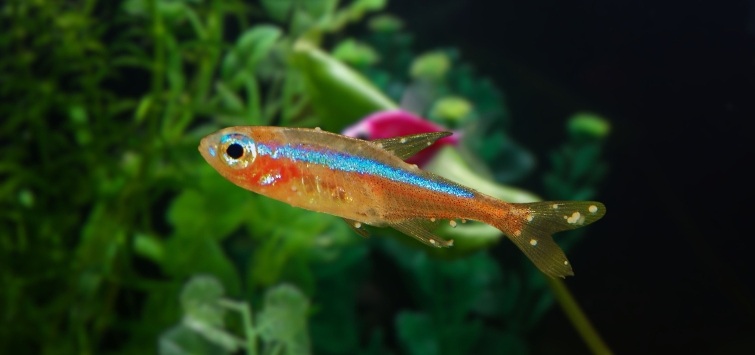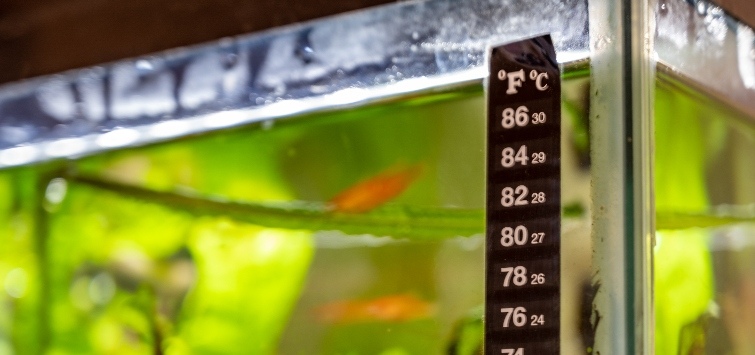Preventing Ich
Author: De-Hai Xu, PhD
Ich is one of the most common fish diseases, but it is fairly preventable and treatable. A scientist lists the best methods to reduce the risk of ich and treat outbreaks in the aquarium.
Everyone Loves Aquariums
Millions of people around the world keep aquariums stocked with colorful ornamental fish, enjoying one of the most popular leisure-time activities. In a 2011—2012 national pet owner survey, the American Pet Products Association (APPA) reported that 12.6 million US households own pet fish. Among them, 11.9 million households have freshwater fish and 0.7 million have saltwater fish.
Currently, huge selections of beautifully colored aquarium fish are available so hobbyists can stock their aquariums to satisfy their taste and add beauty to their homes. Aquariums are often placed in the waiting rooms or lobbies of restaurants, clinical offices, hospitals, commercial buildings, and hotels, providing enjoyment, satisfaction, and relaxation for people in these areas. (If you’re new to the aquarium hobby and seeking some hands-on advice for setting up your first tank, our friends at KaveMan Aquatics have some excellent videos and additional resources.)
Parasites in Fish

Several factors influence the health of aquarium fish, and parasitic disease is a major one. Several major groups of parasites can be seen in aquarium fish. Protozoans are single-celled organisms that typically have a direct lifecycle, requiring no intermediate host to reproduce. Monogenetic trematodes (flatworms or flukes) commonly invade the gills, skin, and fins of fish. They have no intermediate host, but are host- and site-specific—if they are found in one species, they usually will not spread to other species of fish, even in the same tank.
Types of Parasites
Digenetic trematodes (grubs) have a complex lifecycle involving a series of hosts, including snails and birds, nematodes and leeches, meaning they cannot complete their lifecycle in an aquarium because they cannot reproduce. Crustacean parasites come in many types, such as Argulus (fish louse), Lernaea (anchor worm), and Ergasilus (gill lice).
Most of the parasitic diseases encountered in aquarium fish are protozoan parasites, especially those that cause white spot disease. White spot disease is a very common problem in freshwater aquarium fish. The disease is caused by the ciliate protozoan Ichthyophthirius multifiliis, commonly called ich or ick. Fish infected with ich typically develop small, blister-like, raised lesions (white spots) on the skin and/or fins. If the infection is restricted to the gills, however, no white spots will be seen.
Ich infects almost all freshwater fish and has a high mortality rate. All the fish in a tank could be easily killed in a short period. Some aquarium fish may be more sensitive to ich infection than other species, but no fish species has complete natural resistance to ich.
Enjoying TFH Magazine? Subscribe Today!
Lifecycle of Ich
Three Life Stages
Ich is a ciliate parasite that has three developmental stages, a parasitic trophont, a reproductive tomont, and an infective theront. The parasitic trophont lives completely within the host fish, causing tissue damage and leading to the host’s death. The host provides the parasite with food and other necessary substances for growth.
Mature Trophonts
The mature trophont leaves the fish, attaches to the sides and bottom of the aquarium, and secretes a cyst wall to become a reproductive tomont. Each tomont divides from one cell to two cells and then undergoes multiple divisions to produce 100 to 1,000 theronts within a single cyst. Infective theronts then bore their way out of the cyst and swim actively in the water in search of fish to attack. Theronts can swim in the water for two to three days and will die if they cannot find a fish to attack. However, once they find a fish to attack and burrow into its epithelium, the theronts become trophonts and feed on surrounding host tissue until they reach mature size.
Treatment and Prevention of Ich
Whenever any white spots are seen on the skin and fins, fish are most likely infected by the parasite ich. Immediate treatment is required in order to save the infected fish. Parasites can reproduce rapidly, and one mature ich trophont can produce several hundreds to thousands of infective theronts in less than 24 hours at a water temperature of 22° to 25ºC (72º to 77ºF).
Chemical Treatment
Chemical treatment of ich infection is always difficult because the parasite penetrates into the fish’s skin and gills and diseased fish usually cannot tolerate a chemical concentration that is high enough to kill the parasite within the fish’s tissues. The best time to treat infective theronts and reproductive tomonts is when they are still in the water and before they penetrate the fish as trophonts.
Most of the anti-ich chemicals contain formaldehyde, malachite green, copper sulfate, a combination of formaldehyde and malachite green, or a combination of copper sulfate and malachite green. The infected fish can be moved to a quarantine tank in order to avoid treating healthy fish, and less chemical is needed in a smaller tank.
Salt and Water

Other methods, such as adding salt, increasing water temperature, and changing the water are also used by fish hobbyists to treat ich infection in an aquarium. Parasitic trophonts usually stay in fish for five to seven days at a water temperature of 22º to 25ºC (72º to 77ºF). The treatment may need to continue for five days to one week in order to remove the parasite from the infected fish. The complete ich lifecycle lasts three weeks at 9º to 10ºC (48º to 50ºF) but only six days at 24º to 25ºC (75º to 77ºF).
Because of ich’s sensitivity to water temperature, you should heat the aquarium water to about 30ºC (86ºF) for the duration of the treatment, if the fish can tolerate the temperature, to accelerate the lifecycle of the parasite.
Ich Prevention
As is usually the case with disease, an ounce of prevention is worth a pound of cure. The best method for controlling ich infection is prevention. Precautions are needed when establishing an aquarium to prevent ich from being carried by fish, aquatic plants, decorative items, gravel, and water. An aquarium should be set up with everything for one week before the fish are added. Infective theronts usually lose their infectivity after being separated from fish for two to three days.
Quarantining
Fish are major carriers of parasites, but they may not show signs of disease when purchased from pet shops. The newly purchased fish should be quarantined in a separate tank for at least a week to 10 days before adding them to the main aquarium. If the fish show any signs of parasitic infection, they should be treated in the isolation tank without affecting the main aquarium. Before adding new aquatic plants to an established aquarium, they also need to be kept in a separate tank for several days first.
Adding Decorations
Stones/rocks and gravel are commonly used in aquariums as decorations or as a filter for removing waste. A layer of cultured gravel containing colonies of beneficial bacteria can biologically remove waste from the water. However, if the stones/rocks or gravel are collected from rivers or streams, they need to be washed and completely air-dried for two days in order to prevent any parasites from being carried into the aquarium.
Early Detection
In order to keep fish from getting badly infected with ich, early detection of the parasitic infection is critical. The fish in an aquarium need attention at least a few minutes each day to detect any unusual behavior, especially for the first two to three weeks after they have been added to the tank.
In the earliest stage of infection, there are no visible spots on the fish. It is also hard to observe the spots if they are few in number. However, the fish’s behavior may change to flashing suddenly, scratching against rocks and gravel, gulping air, or jumping out of the water—all indications that the fish are infected by parasites and are trying to scratch their itch. When fish are treated during an early infection or a light infection, the chance of survival from parasitic infection is always higher than for a severely infected fish.
Fish Immune Response Against Ich Re-Infection
Fish that survive an ich infection can develop an immune response and become resistant to parasite re-infection. Serum and mucus from those immune fish contain antibodies against the parasite. Then, when infective theronts come into contact with anti-ich antibodies, the antibodies cause the theronts to become immobilized. The immobilization causes the theronts to lose their swimming ability. The antibodies also cause the parasites to leave the fish so that ich cannot become established in immune fish. Recently, a few studies showed that vaccines against ich induced protective immunity and could provide a solution to prevent this parasitic disease through vaccination instead of chemical treatments.

.png?h=595&iar=0&w=2781&hash=5FD5E69473BCC22199FBFA2FB71B6033)



